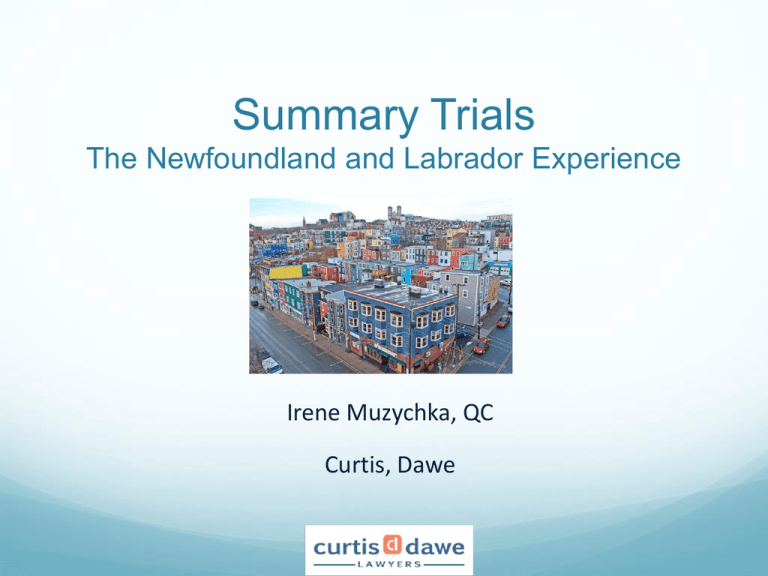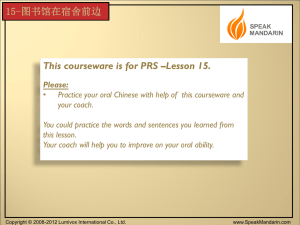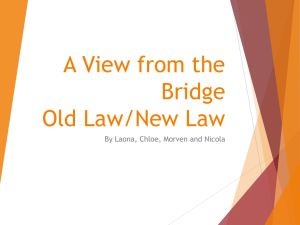Summary Trials The Newfoundland and Labrador Experience
advertisement

Summary Trials The Newfoundland and Labrador Experience Irene Muzychka, QC Curtis, Dawe Rule 17A “The object of rule 17A is to promote the general objective of the Rules of Court of providing an expeditious and inexpensive determination of proceedings on their merits, by screening out claims that cannot survive the "good hard look".” Green J., principle 1, Marco Ltd v Newfoundland Processing Ltd, [1995] 130 Nfld & PEIR 317 Rule 17A came into force January 1, 1995. Rule 17A Rule 17A is similar to British Columbia's Rule 18A. Rule 17A is also similar to Manitoba's Rule 20. All three rules provide that even if the court determines there is an issue for trial it can, nevertheless, proceed to decide the issues on the summary trial application if it is satisfied that the necessary facts are before it, or if it is of the opinion that it would not be unjust to do so. Rule 17A is more robust than the comparable Ontario Rule 20 where, at least in theory, if the court is satisfied there is a genuine issue, the summary judgment application must be dismissed and the matter set down for trial. Daley Brothers Ltd. v Taito Seiko Co., 2001 NFCA 29. Cases citing Rule 17A By Year 12 10 8 6 4 2 0 Number of Cases Marco Ltd v Newfoundland Processing Ltd, [1995] 130 Nfld & PEIR 317. First judicial consideration of a Rule 17A application for summary trial. Green J. (as he then was) looked at previous Ontario and BC cases, as well as the language of Rule 17A, and offered a list of 17 principles as a guideline for approaching application for summary trials. Of 54 Newfoundland decisions that have cited Marco, 11 have reproduced the 17 principles in full. 19 years later, Marco remains the leading case in Newfoundland and Labrador for summary trial applications. Cases Citing Rule 17A & Marco Ltd. 100 90 80 70 60 50 Cases Citing Rule 17A & Marco Ltd. 40 30 20 10 0 Rule 17A Marco Ltd Rule 17A & Marco Ltd Common Trends in Summary Trial Subject Matter 12 10 8 6 4 2 Number of Cases 0 *Of 89 cases citing rule 17A, 43 are represented here. The remaining 46 showed no common trend. When Summary Trials are used: Slip & Fall Curtis v Smith's Home Centre Ltd., 2010 NLCA 7. Motor Vehicle Accident Hannam v Farrell, 2007 NLTD 97. Construction Law Pomerleau Inc v Newfoundland and Labrador (Minister of the Department of Transportation and Works), 2014 NLTD(G) 19. Best Foot Forward “It would not be unjust to decide this case on the materials provided. First of all, each party is required to put "his best foot forward" when applying for summary trial, or opposing the other party's application… While there is no pressing reason to resolve the dispute between the parties, neither is there justification for delaying it unnecessarily or for incurring the significant costs that would follow if I dismissed the Higdons‘ application and thrust these proceedings into the regular trial queue. The application is allowed and this matter will proceed to a summary trial as I directed above.” Higdon v Penney, 2009 NLTD 193 Not Suitable For Summary Trial Evidentiary issues that cannot be resolved Stewart v Martin, 2011 NLTD(G) 128. Genuine issue for trial P(C) v Oblates of Mary Immaculate – St. Rosarie’s Province, 2008 NLTD 6. “The inconsistencies and discrepancies create ambiguity and the interpretation of the contracts and the relevance of any inconsistencies cannot be resolved at a summary trial, given the conflicting evidence and the lack of evidence.” Philpott v Stevens, 2005 NLTD 50. Evidence Issues Resolved “I am satisfied that the materials filed (when the conflicts I have identified are probed in cross-examination) provide a sufficient evidentiary base for resolving all issues between the parties and will allow for an informed and reasoned adjudication of the merits of this case. The presiding judge on a summary trial may draw reasonable inferences from proven facts and can also resolve conflicts in the evidence by referring to other known facts.” Higdon v Penney, 2009 NLTD 193. Considerations for Counsel How to reconcile issues with evidence Consideration of costs Issues with Self-Represented Litigants Is the case optimally suited for summary trial? Hryniak: Does it Change Anything? The Supreme Court of Canada’s recent Hryniak decision is concerned primarily with the rule concerning summary judgment, however, Karakatsanis J. makes reference to summary trials being within judicial discretion and urges that they should be used where appropriate: “The motion judge should look to the summary trial as a model, particularly where affidavits filed could serve as the evidence of a witness, subject to time-limited examinations and cross-examinations.” Hryniak v Mauldin 2014 SCC 7, para 77. Hryniak: Does it Change Anything? Due to the well established jurisprudence regarding summary trials, Hryniak is unlikely to have any substantial impact on the summary trial process in Newfoundland and Labrador.







